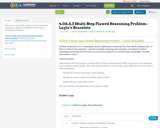
This resource will enable students to determine flawed reasoning in a division word problem that involves interpreting remainders.
- Subject:
- Mathematics
- Material Type:
- Activity/Lab
- Assessment
- Homework/Assignment
- Date Added:
- 08/01/2018

This resource will enable students to determine flawed reasoning in a division word problem that involves interpreting remainders.
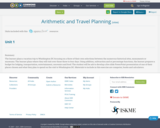
The learner plans a vacation trip to Washington DC focusing on a three of their own selections between the numerous historical sites, monuments or museums. The learner plans where they will visit over those three to four days. Using addition, subtraction and or percentage functions, the learner prepares a budget for lodging, transportation, entertainment, souvenirs and food. The student will be ask to develop a five slide PowerPoint presentation of one of their places chosen and what they plan to spend on the visit to Washington DC. Materials to include in this exercise are computer, books and calculators.
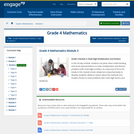
In this 43-day module, students use place value understanding and visual representations to solve multiplication and division problems with multi-digit numbers. As a key area of focus for Grade 4, this module moves slowly but comprehensively to develop students ability to reason about the methods and models chosen to solve problems with multi-digit factors and dividends.
Find the rest of the EngageNY Mathematics resources at https://archive.org/details/engageny-mathematics.
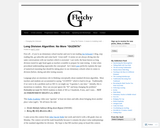
In this blog post and the included lesson plan, Graham Fletcher and Joe Schwartz explore thinking conceptually about the standard division algorithm. In his lesson, Joe Schwartz scaffolds long division using tape diagrams.

This task would be ideal to help students develop mental strategies to think about division during instruction. Jillian's strategy is often referred to as using "compatible numbers." Jillian is using a relationship that she can easily find: 140 divided by 7 is 20 or 20 sets of 7 is 140.
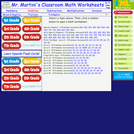
Printable math worksheets for primary math.

(Nota: Esta es una traducción de un recurso educativo abierto creado por el Departamento de Educación del Estado de Nueva York (NYSED) como parte del proyecto "EngageNY" en 2013. Aunque el recurso real fue traducido por personas, la siguiente descripción se tradujo del inglés original usando Google Translate para ayudar a los usuarios potenciales a decidir si se adapta a sus necesidades y puede contener errores gramaticales o lingüísticos. La descripción original en inglés también se proporciona a continuación.)
En este módulo de 43 días, los estudiantes usan la comprensión del valor del lugar y las representaciones visuales para resolver problemas de multiplicación y división con números de múltiples dígitos. Como área clave de enfoque para el grado 4, este módulo se mueve lenta pero exhaustivamente para desarrollar la capacidad de los estudiantes para razonar sobre los métodos y modelos elegidos para resolver problemas con factores y dividendos de múltiples dígitos.
Encuentre el resto de los recursos matemáticos de Engageny en https://archive.org/details/engageny-mathematics.
English Description:
In this 43-day module, students use place value understanding and visual representations to solve multiplication and division problems with multi-digit numbers. As a key area of focus for Grade 4, this module moves slowly but comprehensively to develop students ability to reason about the methods and models chosen to solve problems with multi-digit factors and dividends.
Find the rest of the EngageNY Mathematics resources at https://archive.org/details/engageny-mathematics.
![OREGON MATH STANDARDS (2021): [4.NBT]](https://img.oercommons.org/160x134/oercommons/media/courseware/lesson/image/13138_ODE_Math_Logo_2018-H_color_BvjqVNy.png)
The intent of clarifying statements is to provide additional guidance for educators to communicate the intent of the standard to support the future development of curricular resources and assessments aligned to the 2021 math standards. Clarifying statements can be in the form of succinct sentences or paragraphs that attend to one of four types of clarifications: (1) Student Experiences; (2) Examples; (3) Boundaries; and (4) Connection to Math Practices.

Students strengthen their communicate skills about measurements by learning the meaning of base units and derived units, including speed one of the most common derived units (distance/time). Working in groups, students measure the time for LEGO MINDSTORMS(TM) NXT robots to move a certain distance. The robots are started and stopped via touch sensors and programmed to display the distance traveled. Using their collected data, students complete a worksheet to calculate the robots' (mean/average) speeds at given motor powers.